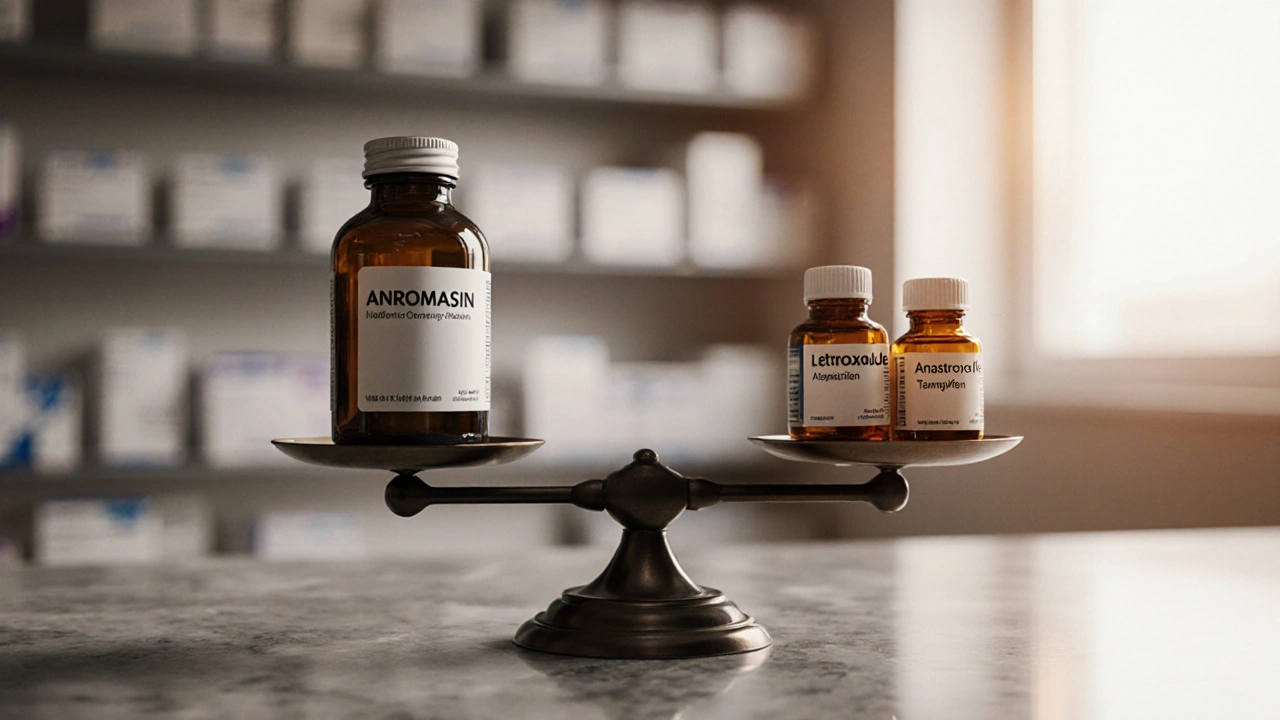Breast Cancer Drug Comparison Tool
Select Your Criteria
Choose your specific situation to find the best matching drug:
Recommended Drug:
Details:
| Drug | Class | Mechanism | Side Effects | Bone Impact | Cost (CAD/30 days) |
|---|
If you’ve been prescribed a hormone‑blocking drug for estrogen‑receptor‑positive breast cancer, you’ve probably heard the name aromasin. But how does it really stack up against other options like letrozole, anastrozole, or even tamoxifen? Below we break down the science, side‑effects, dosing, and cost so you can see which pill fits your situation best.
TL;DR
- Aromasin is a steroidal aromatase inhibitor that irreversibly shuts down estrogen production.
- Letrozole and anastrozole are non‑steroidal inhibitors; they bind reversibly and are usually taken daily.
- Tamoxifen works differently - it blocks estrogen receptors rather than production.
- Side‑effects differ: Aromasin may cause joint pain and hot flashes; letrozole often leads to bone loss; tamoxifen can raise clot risk.
- Cost varies by province; generic aromasin is cheaper than brand‑name, but letrozole’s generic version (Femara) is often the most affordable.
What Is Aromasin (Exemestane)?
Aromasin is a steroidal aromatase inhibitor (AI) whose active ingredient is exemestane. First approved by Health Canada in 2005, it works by permanently binding to the aromatase enzyme, halting the conversion of androgens into estrogen. This irreversible action makes it especially useful after a patient has already taken another AI, such as letrozole or anastrozole, without sufficient response.
Typical dosing is 25mg once daily, taken with or without food. Because it’s a reversible blocker, it’s often prescribed for post‑menopausal women, but some oncologists also use it off‑label for pre‑menopausal patients after ovarian suppression.
How Aromasin Differs from Letrozole
Letrozole (brand name Femara) is a non‑steroidal AI introduced in Canada in 1997. Instead of permanently disabling aromatase, letrozole binds reversibly, meaning the enzyme can recover once the drug is cleared.
Key differences:
- Mechanism: Aromasin’s irreversible binding can lead to more sustained estrogen suppression after missed doses.
- Dosing: Letrozole is taken at 2.5mg daily, a smaller pill but the same frequency.
- Side‑effects: Letrozole is more strongly linked to osteoporosis; patients often need calcium/vitamin D supplementation and periodic bone density scans.
How Aromasin Differs from Anastrozole
Anastrozole (commonly known as Arimidex) entered the market in 1995 and, like letrozole, is a reversible, non‑steroidal AI. Its dose is 1mg daily.
Comparison highlights:
- Potency: Clinical trials suggest letrozole may be slightly more potent than anastrozole, while aromasin sits in the middle due to its irreversible binding.
- Metabolism: Anastrozole is metabolized mainly by CYP3A4; aromasin relies on CYP3A4 and CYP2C19, meaning drug‑drug interactions can differ.
- Joint pain: Patients on aromasin often report higher rates of arthralgia, whereas anastrozole sufferers more commonly notice fatigue.

When Tamoxifen Enters the Picture
Tamoxifen is a selective estrogen receptor modulator (SERM) that blocks estrogen receptors in breast tissue while acting like estrogen in bone and the uterus. It’s been a backbone of breast‑cancer therapy since the 1970s.
Unlike the three AIs, tamoxifen does not lower overall estrogen levels; it merely prevents estrogen from binding to cancer cells. This distinction matters for side‑effect profiles:
- Increased risk of blood clots and stroke, especially in smokers.
- Potential endometrial thickening, requiring gynecologic monitoring.
- Fewer bone‑density losses compared to AIs, sometimes making it a better choice for younger post‑menopausal patients.
Cost and Accessibility in Canada (2025)
Pricing varies by province, but here’s a snapshot of average out‑of‑pocket costs for a 30‑day supply with typical provincial drug plans:
- Aromasin (generic exemestane) -CAD$75-$120
- Letrozole (generic) -CAD$50-$90
- Anastrozole (generic) -CAD$60-$100
- Tamoxifen (generic) -CAD$30-$60
Ontario’s OHIP covers tamoxifen for most indications, while AIs often need a special authorization. If you’re under a private plan, check whether the generic version is on the formulary - it can shave off up to 40% of the price.
Choosing the Right Drug - A Practical Decision Tree
- Is the tumor estrogen‑receptor positive (ER+)? If no, AI or tamoxifen isn’t indicated.
- Post‑menopausal status? AIs (including aromasin) are preferred; tamoxifen works for both but carries clot risk.
- Previous AI exposure? If you’ve already tried letrozole or anastrozole without success, aromasin’s irreversible action may overcome resistance.
- Bone health concerns? Tamoxifen or a bisphosphonate adjunct may be better if you have osteoporosis.
- Cost constraints? Generic anastrozole or letrozole often cost less; check provincial assistance.
Discuss these points with your oncologist. The “best” drug isn’t universal - it depends on your medical history, side‑effect tolerance, and insurance coverage.
Side‑Effect Management Tips
- Joint pain: Low‑impact exercise, omega‑3 supplements, and occasional NSAIDs help mitigate aromasin‑related arthralgia.
- Hot flashes: Wear layered clothing, avoid caffeine, and consider gabapentin if they become severe.
- Bone loss: Calcium 1200mg, vitamin D 800-1000IU daily, and a yearly DEXA scan. Bisphosphonates (e.g., alendronate) are common add‑ons for AI users.
- Clot risk (tamoxifen): Stay active, limit long‑haul flights, and report any leg swelling immediately.
Quick Reference Comparison Table
| Drug | Class | Typical Dose | Mechanism | Common Side‑Effects | Bone Impact | Cost (CAD/30days) |
|---|---|---|---|---|---|---|
| Aromasin (Exemestane) | Steroidal AI | 25mg QD | Irreversible aromatase inhibition | Joint pain, hot flashes, fatigue | Moderate loss (monitor) | $75‑$120 |
| Letrozole (Femara) | Non‑steroidal AI | 2.5mg QD | Reversible aromatase inhibition | Bone loss, fatigue, nausea | High loss (supplement needed) | $50‑$90 |
| Anastrozole (Arimidex) | Non‑steroidal AI | 1mg QD | Reversible aromatase inhibition | Fatigue, arthralgia, rash | Moderate loss | $60‑$100 |
| Tamoxifen | SERM | 20mg QD | Blocks estrogen receptors in breast | Clot risk, endometrial changes, hot flashes | Protects bone | $30‑$60 |

Frequently Asked Questions
Can I switch from letrozole to aromasin if my cancer progresses?
Yes. Because aromasin works irreversibly, it’s often used after a non‑steroidal AI fails. Your oncologist will order a brief wash‑out period (usually 2‑3 weeks) before starting the new drug.
Do I need bone‑density tests while on aromasin?
It's recommended to get a DEXA scan at baseline and then every 1‑2years. Adding calcium, vitamin D, and possibly a bisphosphonate can mitigate loss.
Is aromasin safe during pregnancy?
No. Aromasin is classified as Pregnancy Category D. It can cause fetal harm, so effective contraception is required throughout treatment and for at least 2months after stopping.
How long do I stay on aromasin after surgery?
Standard adjuvant therapy lasts 5years, but some trials suggest extended therapy up to 10years for high‑risk patients. Your oncologist will weigh recurrence risk against side‑effects.
Can I take aromasin with cholesterol‑lowering meds?
Aromasin is metabolized by CYP3A4, so strong inhibitors like clarithromycin can raise its levels. Statins that use the same pathway (e.g., atorvastatin) are usually safe, but always confirm with your pharmacist.








